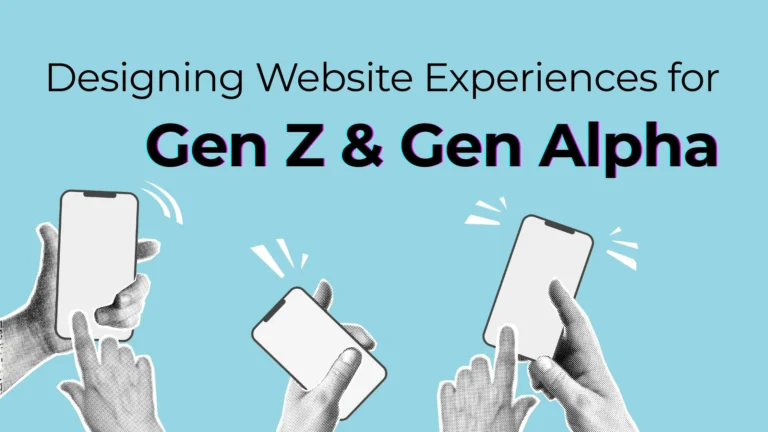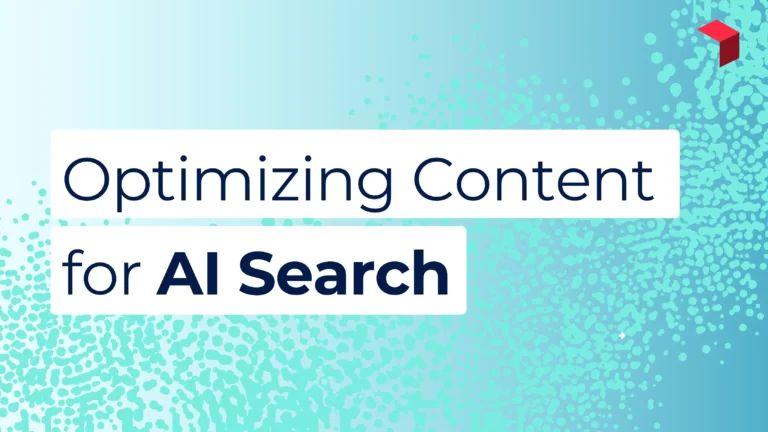US News and World Report’s research presented at the American Marketing Association’s Symposium for Higher Education 2025 found that 47% of Gen Alpha prospective students use AI search to compare schools and 44% use it to research schools. These students are asking ChatGPT, Perplexity, Claude, and Google’s AI mode about your programs—and these tools are scanning your entire institutional web presence to provide answers.
This shift to AI-powered search is an opportunity for Brand, Marketing and Communications teams to address long-standing challenges in higher education website and brand management.
AI Mode uses our query fan-out technique, breaking down your question into subtopics and issuing a multitude of queries simultaneously on your behalf.
- Elizabeth Reid VP, Head of Search, Google
Understanding the New Search Landscape
Higher education institutions typically have operated with federated web presence—colleges, departments, research centers, and faculty maintaining their own sites. This structure gave units autonomy and made sense organizationally.
In traditional search, users could see the URL and understand context. They knew whether they were looking at the official admissions page or a departmental resource from years back.
AI search tools work differently. They use a “fan out” method. Instead of finding one authoritative page, these tools simultaneously scan multiple sources, gathering relevant information from wherever they find it.
When a prospective student asks “What is the tuition at State University?”, the AI fans out across your entire digital presence: the main admissions site, financial aid page, individual college websites, departmental pages, faculty resources, archived news articles, and PDFs uploaded years ago. The AI gathers all mentions of tuition, then synthesizes this into a single answer.
When all sources say the same thing, this reinforces your authority. But when different pages contain different tuition figures, the AI must choose which information to surface. Sometimes it combines conflicting information in confusing ways.
The fan-out method makes content governance critical for federated institutions. The AI may treat your entire web ecosystem as equally valid source material.
Why GEO Is Actually Good News for Higher Ed
AI search is creating institutional need content governance. GEO is your business case for better content management, brand standards, and content cleanup. Building strong content governance delivers multiple strategic benefits:
You protect your institutional brand
There’s now a measurable reason to address abandoned department sites, outdated faculty pages, and forgotten subdomain content. When leadership understands that AI tools pull from these sources to answer prospective students’ questions, cleanup becomes strategic priority.
You remove misinformation at its source
Every outdated page you archive or update eliminates confusion. GEO makes the stakes clearer and ROI easier to demonstrate.
You empower your professional communicators
Strong content governance lets marketing and communications teams manage institutional brand, tone, and voice across your digital presence and maintain coherent brand standards.
You align with institutional content strategy
Clear content ownership, regular review cycles, and archived outdated material turn your web ecosystem into a strategic asset supporting enrollment, advancement, and academic mission.
AI platforms reward authority, freshness, clear structure, proper metadata, and consistent information. This creates value across multiple dimensions: better student experience, stronger brand consistency, efficient operations, and visibility in AI-generated search results.
How Gen Alpha is using AI in college search

The Three Pillars of Effective Higher Ed GEO Governance
Pillar #1: Content Consistency Creates Authority
Content consistency means your core facts—tuition, deadlines, program requirements, contact information—align everywhere they appear. When AI platforms encounter consistent information across multiple pages, they recognize that consistency as authority.
This starts with identifying critical information categories and designating clear content owners. Tuition information, program requirements, and admissions deadlines need singular owners.
Other units can link to these authoritative sources rather than publishing their own versions. That way, departments don’t worry about keeping complex information updated, and students get consistent answers.
Pillar #2: Content Freshness as a Strategic Asset
AI platforms detect and prioritize content with clear freshness signals—this is both a technical fix and a governance fix.
Your CMS can automatically add “last updated” dates, include publish dates in structured data markup, and flag content needing review. These are standard CMS capabilities that need activation and consistent use.
Some universities start with central sites to establish the pattern, then provide templates and support to departments. Others consolidate critical information onto centrally managed platforms while allowing departments freedom with less critical content.
Pillar #3: Strategic Content Lifecycle Management
Every outdated page is a potential source of confusion and an opportunity for improvement. Clear protocols for content lifecycle management mean you’re actively curating your digital presence.
What happens to program pages when programs evolve? How long should event pages remain live? When should research project sites be archived? Clear answers make everyone’s job easier.
Content lifecycle management doesn’t mean destroying institutional history. It means being intentional about what remains discoverable versus what gets preserved in clearly marked archives.
A Practical, Achievable Path Forward
You don’t have to solve everything at once. The most successful approaches are incremental and strategic.
Start with critical content pathways
What information do prospective students and their families need most? Map where that information lives across your digital ecosystem.
Establish single sources of truth strategically
Pick one critical data category and designate it as the authoritative source. Learn from the process, then expand.
Implement technical improvements progressively
Configure your main CMS with proper structured data and freshness signals first. This creates a model other sites can follow.
Build cross-functional relationships
GEO success requires collaboration across multiple teams and offices. These conversations reveal opportunities and create alignment that benefit everyone.
Create reasonable implementation timeline
Establish reasonable timelines and priorities that acknowledge current realities while moving toward better practices where possible.
The Competitive Advantage Ahead
When your content consistently provides accurate, current information with clear structure and proper metadata, these platforms learn to trust your content. Prospective students get better information about your institution, leading to better-informed decisions and better enrollment outcomes.
Every improvement to your content governance strengthens your position in AI-generated results. Every outdated page you remove lowers the risk of people being served outdated information. Every governance policy you implement makes future improvements easier.
You don’t have to be perfect. You have to be intentional, consistent, and committed to continuous improvement. That’s achievable, and the competitive advantages are substantial and lasting.
FAQs: AI Search and Content Governance for Higher Education
When someone asks an AI search tool a question about your university, the tool doesn’t just find one page with the answer. Instead, it simultaneously searches across your entire digital presence—admissions pages, department sites, faculty pages, PDFs, archived content—gathering information from everywhere it finds relevant mentions. It then synthesizes all this information into a single response. This means outdated content on a forgotten departmental site has just as much chance of being included as your official admissions page.
In traditional search, users could see the URL and understand context—they knew if they were on an official page or an old department site. AI search tools remove this context. When they fan out across your institution’s federated web structure, they treat all sources as potentially valid. If your chemistry department posted scholarship information in 2022 and never updated it, AI tools might surface that information alongside current information, creating confusion or combining conflicting details in problematic ways.
GEO (Generative Engine Optimization) focuses on making your content work well with AI-powered search platforms like ChatGPT, Perplexity, Claude, and Google’s AI mode. According to US News and World Report’s 2025 research, 47% of Gen Alpha prospective students use AI search to compare schools. GEO matters because these tools are now how students research and evaluate institutions—and they’re pulling from your entire digital ecosystem to answer questions.
Content governance creates consistency across your digital presence, which AI platforms interpret as authority. When your tuition information, program requirements, and deadlines align everywhere they appear, AI tools recognize this consistency and are more likely to surface your content confidently. Governance also ensures proper metadata, freshness signals, and clear structure—all factors that AI platforms prioritize when determining which sources to cite.
Content Consistency means your core facts align everywhere they appear across your institution’s digital presence. Content Freshness involves technical signals like “last updated” dates and structured data markup that help AI platforms identify current information. Strategic Content Lifecycle Management establishes clear protocols for what happens to pages over time—when to update, when to archive, and how to preserve institutional history without leaving outdated information discoverable.
No. The most successful approaches are incremental. Start by mapping where critical information lives across your digital ecosystem—focus on what prospective students need most. Pick one data category (like tuition or admissions deadlines) and designate it as the authoritative source. Learn from that process, then expand. Configure your main CMS with proper structured data first, creating a model other sites can follow. Build reasonable timelines that acknowledge current realities.
Rather than trying to control everything, focus on creating clear content ownership and single sources of truth for critical information. Departments can link to authoritative central pages instead of publishing their own versions. This relieves departments from maintaining complex information while ensuring students get consistent answers. Provide templates and support for departments managing less critical content, and establish clear protocols for content review cycles.
When leadership understands that AI tools answering prospective students’ questions are pulling from abandoned department sites and outdated faculty pages, cleanup becomes a strategic priority. Strong governance protects your brand, removes misinformation at its source, empowers your communications teams, and aligns with broader institutional strategy. The ROI shows up in better student experience, stronger brand consistency, and improved visibility in AI-generated results.
Content lifecycle management doesn’t mean destroying history. It means being intentional about what remains discoverable on the website. Modern institutional websites should not be treated as storage folders. Clear archival practices actually protect your history while improving the accuracy of information students find.





